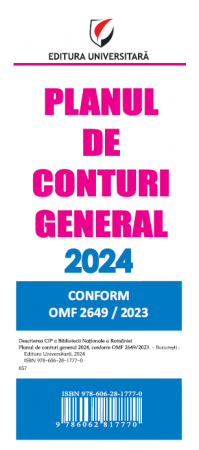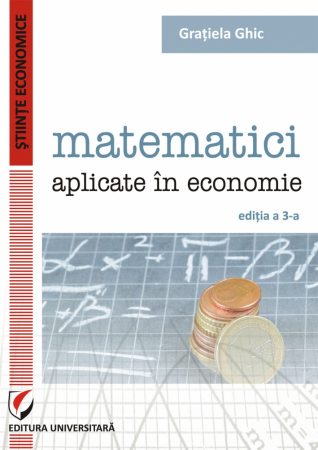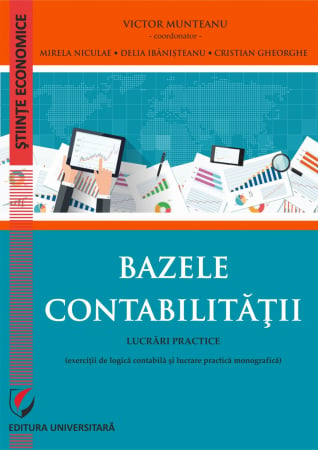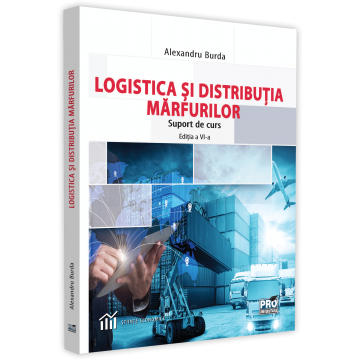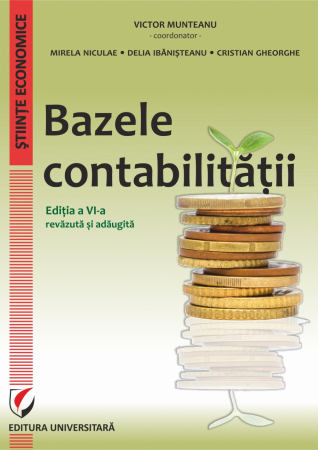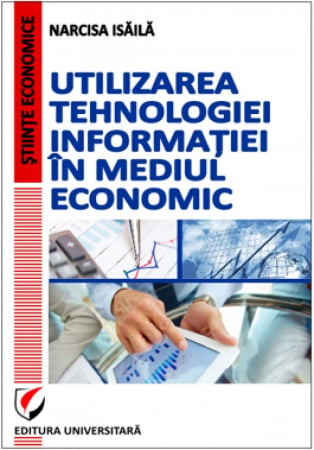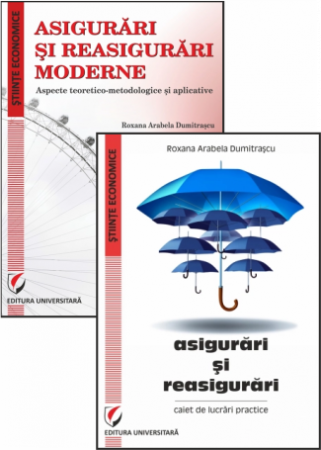Manuscript proposals: [email protected] / 0745 204 115 //// Tracking orders Individuals / Sales: 0745 200 357 / Orders Legal entities: 0721 722 783
Publisher: Editura Universitară
Author: Maria Denisa Vasilescu
ISBN: 978-606-28-0345-2
DOI: 10.5682/9786062803452
Publisher year: 2015
Edition: I
Pages: 142
Product Code:
9786062803452
Do you need help?
0745 200 357
- Description
- Download (1)
- Authors
- Content
- More details
- Reviews (0)
The main purpose of this paper: to evaluate the processes on the labor market, to determine the factors that influence the demand, labor supply or wages and to identify the main problems currently facing the labor market at national level: migration, unemployment, undeclared work.
The approach used is a rigorous one, the starting point considered being the theory of labor economy. In addition to this solid foundation, experience is added at national and international level, by studying a significant number of specialized works in the field, both the reference ones and the latest publications. The next step is to identify and then adapt the existing models to the particularities of the Romanian labor market and use the methods and tools of analysis best suited to a particular context or data set. The methods used are diverse: econometric models on time series, econometric models on panel data, forecast models, nonparametric methods for performance evaluation. All these allow obtaining reliable results, extremely interesting and useful in formulating recommendations or directions for action.
The paper is composed of five chapters, plus the final part designed to summarize the most important results and present the main conclusions and recommendations.
The approach used is a rigorous one, the starting point considered being the theory of labor economy. In addition to this solid foundation, experience is added at national and international level, by studying a significant number of specialized works in the field, both the reference ones and the latest publications. The next step is to identify and then adapt the existing models to the particularities of the Romanian labor market and use the methods and tools of analysis best suited to a particular context or data set. The methods used are diverse: econometric models on time series, econometric models on panel data, forecast models, nonparametric methods for performance evaluation. All these allow obtaining reliable results, extremely interesting and useful in formulating recommendations or directions for action.
The paper is composed of five chapters, plus the final part designed to summarize the most important results and present the main conclusions and recommendations.
-
PIATA FORTEI DE MUNCA DIN ROMANIA - CARACTERISTICI SI DEZECHILIBRE
Download
MARIA DENISA VASILESCU
INTRODUCTION / 6
1. DEMAND FOR LABOR / 16
1.1. THEORETICAL CONSIDERATIONS / 16
1.2. ESTIMATING THE ELASTICITIES OF THE LABOR DEMAND FOR ROMANIA / 20
2. LABOR SUPPLY / 28
2.1. CHARACTERISTICS OF THE INTERNATIONAL LABOR SUPPLY / 29
2.2. LABOR SUPPLY ANALYSIS IN ROMANIA / 34
2.3. INFLUENCE FACTORS OF THE LABOR SUPPLY IN ROMANIA / 42
3. UNEMPLOYMENT AMONG YOUNG PEOPLE / 46
3.1. CHARACTERISTICS OF UNEMPLOYMENT UNDER YOUTH / 47
3.2. ANALYSIS OF YOUTH UNEMPLOYMENT IN ROMANIA VERSUS OTHER MEMBER STATES OF THE EUROPEAN UNION / 56
3.2.1. Assessing the labor market performance of young people in EU Member States using the data wrapping method (DEA) / 63
3.2.2. Analysis of the determining factors of youth unemployment based on models with panel data / 68
4. MIGRATION IN ROMANIA - CHARACTERISTICS AND EFFECTS / 72
4.1. THEORIES OF MIGRATION / 72
4.2. MIGRATION FROM THE PERSPECTIVE OF THE COUNTRY OF DESTINATION / 82
4.3. MIGRATION FROM THE PERSPECTIVE OF THE COUNTRY OF ORIGIN / 84
4.4. CHARACTERIZATION OF THE MIGRATION PHENOMENON IN ROMANIA / 86
4.5. THE IMPACT OF MIGRATION ON THE AVERAGE SALARY IN ROMANIA / 93
5. ANALYSIS OF THE PHENOMENON OF UNDECLARED WORK IN ROMANIA / 106
5.1. THE SITUATION AT THE INTERNATIONAL PLAN / 106
5.2. UNDECLARED WORK IN ROMANIA - RESULTS BASED ON INVESTIGATION / 109
CONCLUSIONS / 121
BIBLIOGRAPHY / 130
1. DEMAND FOR LABOR / 16
1.1. THEORETICAL CONSIDERATIONS / 16
1.2. ESTIMATING THE ELASTICITIES OF THE LABOR DEMAND FOR ROMANIA / 20
2. LABOR SUPPLY / 28
2.1. CHARACTERISTICS OF THE INTERNATIONAL LABOR SUPPLY / 29
2.2. LABOR SUPPLY ANALYSIS IN ROMANIA / 34
2.3. INFLUENCE FACTORS OF THE LABOR SUPPLY IN ROMANIA / 42
3. UNEMPLOYMENT AMONG YOUNG PEOPLE / 46
3.1. CHARACTERISTICS OF UNEMPLOYMENT UNDER YOUTH / 47
3.2. ANALYSIS OF YOUTH UNEMPLOYMENT IN ROMANIA VERSUS OTHER MEMBER STATES OF THE EUROPEAN UNION / 56
3.2.1. Assessing the labor market performance of young people in EU Member States using the data wrapping method (DEA) / 63
3.2.2. Analysis of the determining factors of youth unemployment based on models with panel data / 68
4. MIGRATION IN ROMANIA - CHARACTERISTICS AND EFFECTS / 72
4.1. THEORIES OF MIGRATION / 72
4.2. MIGRATION FROM THE PERSPECTIVE OF THE COUNTRY OF DESTINATION / 82
4.3. MIGRATION FROM THE PERSPECTIVE OF THE COUNTRY OF ORIGIN / 84
4.4. CHARACTERIZATION OF THE MIGRATION PHENOMENON IN ROMANIA / 86
4.5. THE IMPACT OF MIGRATION ON THE AVERAGE SALARY IN ROMANIA / 93
5. ANALYSIS OF THE PHENOMENON OF UNDECLARED WORK IN ROMANIA / 106
5.1. THE SITUATION AT THE INTERNATIONAL PLAN / 106
5.2. UNDECLARED WORK IN ROMANIA - RESULTS BASED ON INVESTIGATION / 109
CONCLUSIONS / 121
BIBLIOGRAPHY / 130
The study of the labor market is important, because its good functioning is vital for the competitiveness of the economy, both now and in the future. When competitiveness is seen as potential for growth, the size of available resources and the efficiency of their use become essential. The contribution of human resources to economic competitiveness is determined by the size of the labor supply, its qualification and the flexibility of the labor market.
The less favorable economic conditions in recent years have also had a significant impact on the labor market, causing serious imbalances. The unemployment rate has increased significantly, even worryingly in some EU member states (Greece, Spain, Portugal), long-term unemployment has increased, there are difficulties in the job-matching process, the creation of new jobs has decreased significantly. Internally, we also face a massive phenomenon of emigration, which affects all geographical regions and all social categories, influencing the evolution of the demographic situation and the labor market. The migration of highly qualified people - engineers, technical specialists, doctors, nurses, researchers, teachers - has strong implications for the potential for economic and social development of Romania and endangers the sustainability of health and education systems. Another worrying aspect is undeclared work, with consequences both on the employee - lower wages, decreased pension rights, reduced access to medical services, poor working conditions, low chances of career advancement, and on society as a whole - lower incomes collected from the state budget undermines the financing and distribution of social welfare. All these difficulties encountered by the labor market hinder the functioning of the economy as a whole and slow down the process of economic growth.
At the international level, special efforts are being made to design and implement effective strategies and policies in order to improve the functioning of the labor market. Organizations such as the European Commission, the International Labor Organization, the International Monetary Fund are actively involved in the study of labor market issues and the formulation of recommendations, encouraging national governments to treat these difficulties with the utmost seriousness.
Given that the world we live in is characterized by continuous change, and this exceptional dynamic reaches all areas, the study of the labor market can not be limited to the analysis of factors directly involved in the processes in this market, because everything is in interaction. Globalization, technological progress, the enormous amount of information existing in the virtual world and easy access to them, the development of the communications network, paradigm shifts in management - emphasis on leadership and increased attention to the worker as a unique person with specific talents and abilities, progress in the medical field that has determined the increase of life expectancy, the political influences at global level, all these and not only, are part of the current reality and exert their influence on the labor market.
Thus, the main purpose of this paper is: evaluating the processes on the labor market, determining the factors that influence demand, labor supply or wages and identifying the main problems currently facing the labor market at the national level: migration, unemployment, undeclared work.
The approach used is a rigorous one, the starting point considered being the theory of labor economy. In addition to this solid foundation, experience is added at national and international level, by studying a significant number of specialized works in the field, both the reference ones and the latest publications. The next step is to identify and then adapt the existing models to the particularities of the Romanian labor market and use the methods and tools of analysis best suited to a particular context or data set. The methods used are diverse: econometric models on time series, econometric models on panel data, forecast models, nonparametric methods for performance evaluation. All these allow obtaining reliable results, extremely interesting and useful in formulating recommendations or directions for action.
The paper is composed of five chapters, plus the final part designed to summarize the most important results and present the main conclusions and recommendations.
The first chapter, Labor Demand, describes one of the essential components of the labor market. In a broader context, labor demand reflects the vitality and viability of an economy, as well as the way its mechanisms work. Providing jobs for all individuals willing to work it is a fundamental element in the design of development strategies and a factor of social and political balance. Under these conditions, it is easy to understand the increased interest in understanding the factors that stimulate, balance and strengthen labor demand.
The analysis carried out in this chapter aims to identify the particularities of the Romanian labor force demand and to estimate the elasticity of the salary, of the capital and of the output in relation to the employment. The conditioned function of labor demand is used to control the possible shocks of product demand, along with their impact on labor demand. The model used is based on a Cobb-Douglas production function, and the variables used refer to: gross domestic product (for output), employment rate (labor), gross fixed capital formation (capital) and average gross monthly earnings (control variable for labor cost). Quantitative analysis takes into account quarterly data for estimating a model by time series, using the least squares method.
Chapter 2 is intended to investigate the Labor Supply. It begins with the presentation of the situation at the international level, illustrating the importance of this topic through the vast specialized literature that indicates the interest of researchers for the determinants of the job offer.
In general, the size of labor resources is under the influence of demographic and socio-economic factors. Demographic factors target the birth rate, mortality, life expectancy, migratory flows, while socio-economic factors may include education, economic development (wages, GDP per capita), but also labor legislation.
The analysis of the labor supply in Romania begins with a short presentation of the Romanian economy after the '90s as well as a detailed statistical analysis of the situation in Romania from the point of view of the evolution of some indicators closely related to the labor supply: employment rate, earnings, post-secondary and university graduates, birth and mortality rates, but also the number of emigrants and immigrants, respectively.
Quantitative modeling aimed to determine the main influencing factors of labor supply and was based on the econometric estimation of a model with panel data, using information for all 42 counties of our country. The indicators specified above were used as variables of the model, proving their significant impact on the labor supply.
The third chapter, Unemployment among young people, deals with a very topical issue. In many economies, young people are two to three times more likely than adults to be unemployed, and the problem is growing rapidly in almost every region of the world. Although today's young people are the most educated generation to date, both industrialized and developing countries fail to increase employment opportunities for them. The lack of opportunities is, of course, related to the general state of the economy and the employment situation, but it is also a result of inconsistencies between the skills that young people possess and the skills required by the labor market. All these factors can lead to long periods of unemployment or to the employment of young people in less qualified positions, aspects that are not only to the detriment of young people, but also have a significant negative impact on the economy and society in general.
For these reasons, the need for detailed studies in this field is obvious and vital in formulating specific policies for young people, designed to facilitate their integration into the labor market and reduce the unemployment rate. At the same time, it is worth analyzing the states that demonstrate good practices in the field of youth employment in order to be able to take over, adapt and insert as much as possible these policies at the level of lower performing countries on the youth labor market.
In this context, we studied the problem of youth unemployment in Romania and in the European Union, using as methods of analysis econometric modeling with panel data and comparison of Member States in relation to their performance on the youth labor market, using the DEA method. (Data wrap analysis).
In the first stage of the research, we used data wrap analysis (DEA) as a multi-input multi-output optimization model to measure the relative efficiency of the youth labor market in relation to the best performing reference countries. We chose an output-oriented model and used two result indicators and four to define resources. The output variables are: youth unemployment rate and labor productivity, in the form of gross domestic product per capita. Regarding the input variables, I have taken into account: youth activity rate, research and development expenditures, capital investments and level of education.
In the panel analysis, the dependent variable was the youth unemployment rate, while the explanatory variables considered were: gross domestic product per capita, share of research and development expenditures in gross domestic product, share of gross training expenditure fixed capital in the gross domestic product and the share of graduates. It is easy to see that they are about the same variables as those considered in the DEA analysis, which is not accidental. This quantitative analysis carried out through panel-type econometric modeling aimed, in addition to determining the magnitude of the influence of these indicators on youth unemployment, and highlighting the importance of these factors in studying the functioning of the labor market, especially for young people. .
Chapter 4, Migration in Romania - characteristics and effects, focuses on a particularly important situation for the Romanian economy and deals with this extremely rigorous topic.
The beginning of the chapter takes the form of a theoretical presentation of the main theories in the field of migration, synthesizing very well this broad field, with many facets and levels of analysis. One by one, different theories are exposed, together with the criticisms brought to them, as well as the advantages and disadvantages that appear especially from the point of view of sustainability in front of the empirical applications.
It continues with an international analysis of the main effects of migration. Three perspectives are approached, corresponding to the 3 actors involved in the act of international migration: the migrants, the country of origin and the country of destination, taking into account the fact that each of these parties has its own interests, sometimes contradictory.
The effect of migration on host countries is a topic of great interest to developed countries, with numerous studies focusing on measuring and analyzing the effect of immigrants on the destination country. A number of advantages have been identified as a result of the influx of foreign population: employers benefit from a flexible and abundant labor supply, consumers enjoy lower prices, the entire economy has to gain from the talent of immigrants and everyone is advantaged the fact that immigrants accept hard-to-cover jobs. Among the disadvantages affecting host countries is the emphasis on the fact that native workers suffer because of the cheap labor of immigrants. Among the benefits that the country of origin feels are, of course, remittances, encouraged by both the host country and the country of origin. The main cost associated with migration for the country of origin is the phenomenon of "brain drain" - when migrants are highly qualified, the country of origin experiences a double loss, both that of the worker and the investments made in education.
This chapter continues with the detailing of the situation in Romania regarding the migration pattern, being identified the main characteristics of this phenomenon but especially the effects felt in the Romanian economy, with emphasis on the labor market.
In the period 1990-2000, as a result of the economic transition, the number of available jobs decreased radically and migration appeared as a reaction to the inability of the Romanian economy to create jobs and absorb the existing labor force. From the state's perspective, migration has functioned as a safety valve, significantly reducing the number of social assistance beneficiaries since they left the country. Thus, migration has reduced the social costs of the transition and reduced the risk of social tensions. In the period 2001-2008, the Romanian economy grew at an impressive average rate, and its structure underwent important changes, consisting essentially in the transition from industry and agriculture to service and construction activities. But these fields of activity faced a serious labor shortage, directly related to the emigration of the Romanian labor force. Romanians prefer to work abroad in construction, trade, hotels and restaurants, domestic and care services, earning at least twice as much as if they did the same thing in the country. And after 2009 the personnel deficit was above the European average, already speaking in the specialized literature of a structural deficit, largely determined by emigration.
Another worrying aspect in Romania is the phenomenon of "brain drain", several important categories of highly qualified staff can be mentioned: IT specialists, engineers, researchers, technical professionals, doctors and nurses, as well as teachers.
Chapter 4 aims to quantify the impact of migration on earnings in Romania, being built on two levels: at the national level and at the level of each macro-region. As the method of analysis is used the econometric estimation of the panel type models, using data by counties. Along with the number of emigrants, respectively immigrants, the unemployment rate, labor productivity, the number of graduates of higher education and the number of graduates of post-secondary education are used as explanatory variables. The results of the constructed models allow both the evaluation of the situation at national level, and the comparison and identification of the particularities of the four macroregions. At the same time, due to the inclusion in the models of labor productivity, a very important correlation can be analyzed for the good functioning of the labor market, namely that between wages and productivity.
Chapter 5, Analysis of the phenomenon of undeclared work in Romania, addresses a topic of great interest because informal employment is one of the characteristics of the Romanian labor market, being a widespread and persistent problem, even in periods of economic growth. When analyzing undeclared work, a distinction must be made between those who work illegally because they do not have a real alternative, informal work being a survival strategy and those who deliberately evade paying taxes and social security contributions.
The study carried out in this chapter uses information obtained from a nationally representative survey, the recorded data offering the possibility to outline the profile of the person working illegally, to identify areas where undeclared work is frequent or how much is earned from informal activities. The analysis continues with the investigation of the reasons why a person would engage in undeclared activities and studies the perception of individuals on the advantages and disadvantages of undeclared work. An interesting aspect included in the questionnaire is related to the measures that would reduce the phenomenon of undeclared work, according to the respondents.
Also, the analysis based on the survey allows the identification of a vulnerable group, people aged 50 and over, as the majority of workers who perform undeclared work. This polarization indicates the shortcomings of the pension system - a large part of retirees being forced to supplement their income through undeclared work, but also the difficulties of these people in finding a formal job following changes in the economy during the transition period. the centralized economy to the market economy. Many of the basic qualifications of these people are no longer relevant, the changes in labor demand leading to their exclusion from the labor market. Thus, undeclared work has become for some of them the only alternative for survival and, in addition, many of them work in fields below the level of training.
The entire research undertaken in this paper is meant to complete the knowledge base in the field of labor market and to provide support, both at the theoretical-methodological level and at the applicative level, to all actors interested in this field, from simple passionate readers, to students and last but not least to political decision makers, directly involved in labor market policy making . The research, extensive and carefully structured, is perfectly aligned with similar studies conducted internationally and, using complex methods of analysis, leads to very interesting empirical results, with high applicability potential.
The less favorable economic conditions in recent years have also had a significant impact on the labor market, causing serious imbalances. The unemployment rate has increased significantly, even worryingly in some EU member states (Greece, Spain, Portugal), long-term unemployment has increased, there are difficulties in the job-matching process, the creation of new jobs has decreased significantly. Internally, we also face a massive phenomenon of emigration, which affects all geographical regions and all social categories, influencing the evolution of the demographic situation and the labor market. The migration of highly qualified people - engineers, technical specialists, doctors, nurses, researchers, teachers - has strong implications for the potential for economic and social development of Romania and endangers the sustainability of health and education systems. Another worrying aspect is undeclared work, with consequences both on the employee - lower wages, decreased pension rights, reduced access to medical services, poor working conditions, low chances of career advancement, and on society as a whole - lower incomes collected from the state budget undermines the financing and distribution of social welfare. All these difficulties encountered by the labor market hinder the functioning of the economy as a whole and slow down the process of economic growth.
At the international level, special efforts are being made to design and implement effective strategies and policies in order to improve the functioning of the labor market. Organizations such as the European Commission, the International Labor Organization, the International Monetary Fund are actively involved in the study of labor market issues and the formulation of recommendations, encouraging national governments to treat these difficulties with the utmost seriousness.
Given that the world we live in is characterized by continuous change, and this exceptional dynamic reaches all areas, the study of the labor market can not be limited to the analysis of factors directly involved in the processes in this market, because everything is in interaction. Globalization, technological progress, the enormous amount of information existing in the virtual world and easy access to them, the development of the communications network, paradigm shifts in management - emphasis on leadership and increased attention to the worker as a unique person with specific talents and abilities, progress in the medical field that has determined the increase of life expectancy, the political influences at global level, all these and not only, are part of the current reality and exert their influence on the labor market.
Thus, the main purpose of this paper is: evaluating the processes on the labor market, determining the factors that influence demand, labor supply or wages and identifying the main problems currently facing the labor market at the national level: migration, unemployment, undeclared work.
The approach used is a rigorous one, the starting point considered being the theory of labor economy. In addition to this solid foundation, experience is added at national and international level, by studying a significant number of specialized works in the field, both the reference ones and the latest publications. The next step is to identify and then adapt the existing models to the particularities of the Romanian labor market and use the methods and tools of analysis best suited to a particular context or data set. The methods used are diverse: econometric models on time series, econometric models on panel data, forecast models, nonparametric methods for performance evaluation. All these allow obtaining reliable results, extremely interesting and useful in formulating recommendations or directions for action.
The paper is composed of five chapters, plus the final part designed to summarize the most important results and present the main conclusions and recommendations.
The first chapter, Labor Demand, describes one of the essential components of the labor market. In a broader context, labor demand reflects the vitality and viability of an economy, as well as the way its mechanisms work. Providing jobs for all individuals willing to work it is a fundamental element in the design of development strategies and a factor of social and political balance. Under these conditions, it is easy to understand the increased interest in understanding the factors that stimulate, balance and strengthen labor demand.
The analysis carried out in this chapter aims to identify the particularities of the Romanian labor force demand and to estimate the elasticity of the salary, of the capital and of the output in relation to the employment. The conditioned function of labor demand is used to control the possible shocks of product demand, along with their impact on labor demand. The model used is based on a Cobb-Douglas production function, and the variables used refer to: gross domestic product (for output), employment rate (labor), gross fixed capital formation (capital) and average gross monthly earnings (control variable for labor cost). Quantitative analysis takes into account quarterly data for estimating a model by time series, using the least squares method.
Chapter 2 is intended to investigate the Labor Supply. It begins with the presentation of the situation at the international level, illustrating the importance of this topic through the vast specialized literature that indicates the interest of researchers for the determinants of the job offer.
In general, the size of labor resources is under the influence of demographic and socio-economic factors. Demographic factors target the birth rate, mortality, life expectancy, migratory flows, while socio-economic factors may include education, economic development (wages, GDP per capita), but also labor legislation.
The analysis of the labor supply in Romania begins with a short presentation of the Romanian economy after the '90s as well as a detailed statistical analysis of the situation in Romania from the point of view of the evolution of some indicators closely related to the labor supply: employment rate, earnings, post-secondary and university graduates, birth and mortality rates, but also the number of emigrants and immigrants, respectively.
Quantitative modeling aimed to determine the main influencing factors of labor supply and was based on the econometric estimation of a model with panel data, using information for all 42 counties of our country. The indicators specified above were used as variables of the model, proving their significant impact on the labor supply.
The third chapter, Unemployment among young people, deals with a very topical issue. In many economies, young people are two to three times more likely than adults to be unemployed, and the problem is growing rapidly in almost every region of the world. Although today's young people are the most educated generation to date, both industrialized and developing countries fail to increase employment opportunities for them. The lack of opportunities is, of course, related to the general state of the economy and the employment situation, but it is also a result of inconsistencies between the skills that young people possess and the skills required by the labor market. All these factors can lead to long periods of unemployment or to the employment of young people in less qualified positions, aspects that are not only to the detriment of young people, but also have a significant negative impact on the economy and society in general.
For these reasons, the need for detailed studies in this field is obvious and vital in formulating specific policies for young people, designed to facilitate their integration into the labor market and reduce the unemployment rate. At the same time, it is worth analyzing the states that demonstrate good practices in the field of youth employment in order to be able to take over, adapt and insert as much as possible these policies at the level of lower performing countries on the youth labor market.
In this context, we studied the problem of youth unemployment in Romania and in the European Union, using as methods of analysis econometric modeling with panel data and comparison of Member States in relation to their performance on the youth labor market, using the DEA method. (Data wrap analysis).
In the first stage of the research, we used data wrap analysis (DEA) as a multi-input multi-output optimization model to measure the relative efficiency of the youth labor market in relation to the best performing reference countries. We chose an output-oriented model and used two result indicators and four to define resources. The output variables are: youth unemployment rate and labor productivity, in the form of gross domestic product per capita. Regarding the input variables, I have taken into account: youth activity rate, research and development expenditures, capital investments and level of education.
In the panel analysis, the dependent variable was the youth unemployment rate, while the explanatory variables considered were: gross domestic product per capita, share of research and development expenditures in gross domestic product, share of gross training expenditure fixed capital in the gross domestic product and the share of graduates. It is easy to see that they are about the same variables as those considered in the DEA analysis, which is not accidental. This quantitative analysis carried out through panel-type econometric modeling aimed, in addition to determining the magnitude of the influence of these indicators on youth unemployment, and highlighting the importance of these factors in studying the functioning of the labor market, especially for young people. .
Chapter 4, Migration in Romania - characteristics and effects, focuses on a particularly important situation for the Romanian economy and deals with this extremely rigorous topic.
The beginning of the chapter takes the form of a theoretical presentation of the main theories in the field of migration, synthesizing very well this broad field, with many facets and levels of analysis. One by one, different theories are exposed, together with the criticisms brought to them, as well as the advantages and disadvantages that appear especially from the point of view of sustainability in front of the empirical applications.
It continues with an international analysis of the main effects of migration. Three perspectives are approached, corresponding to the 3 actors involved in the act of international migration: the migrants, the country of origin and the country of destination, taking into account the fact that each of these parties has its own interests, sometimes contradictory.
The effect of migration on host countries is a topic of great interest to developed countries, with numerous studies focusing on measuring and analyzing the effect of immigrants on the destination country. A number of advantages have been identified as a result of the influx of foreign population: employers benefit from a flexible and abundant labor supply, consumers enjoy lower prices, the entire economy has to gain from the talent of immigrants and everyone is advantaged the fact that immigrants accept hard-to-cover jobs. Among the disadvantages affecting host countries is the emphasis on the fact that native workers suffer because of the cheap labor of immigrants. Among the benefits that the country of origin feels are, of course, remittances, encouraged by both the host country and the country of origin. The main cost associated with migration for the country of origin is the phenomenon of "brain drain" - when migrants are highly qualified, the country of origin experiences a double loss, both that of the worker and the investments made in education.
This chapter continues with the detailing of the situation in Romania regarding the migration pattern, being identified the main characteristics of this phenomenon but especially the effects felt in the Romanian economy, with emphasis on the labor market.
In the period 1990-2000, as a result of the economic transition, the number of available jobs decreased radically and migration appeared as a reaction to the inability of the Romanian economy to create jobs and absorb the existing labor force. From the state's perspective, migration has functioned as a safety valve, significantly reducing the number of social assistance beneficiaries since they left the country. Thus, migration has reduced the social costs of the transition and reduced the risk of social tensions. In the period 2001-2008, the Romanian economy grew at an impressive average rate, and its structure underwent important changes, consisting essentially in the transition from industry and agriculture to service and construction activities. But these fields of activity faced a serious labor shortage, directly related to the emigration of the Romanian labor force. Romanians prefer to work abroad in construction, trade, hotels and restaurants, domestic and care services, earning at least twice as much as if they did the same thing in the country. And after 2009 the personnel deficit was above the European average, already speaking in the specialized literature of a structural deficit, largely determined by emigration.
Another worrying aspect in Romania is the phenomenon of "brain drain", several important categories of highly qualified staff can be mentioned: IT specialists, engineers, researchers, technical professionals, doctors and nurses, as well as teachers.
Chapter 4 aims to quantify the impact of migration on earnings in Romania, being built on two levels: at the national level and at the level of each macro-region. As the method of analysis is used the econometric estimation of the panel type models, using data by counties. Along with the number of emigrants, respectively immigrants, the unemployment rate, labor productivity, the number of graduates of higher education and the number of graduates of post-secondary education are used as explanatory variables. The results of the constructed models allow both the evaluation of the situation at national level, and the comparison and identification of the particularities of the four macroregions. At the same time, due to the inclusion in the models of labor productivity, a very important correlation can be analyzed for the good functioning of the labor market, namely that between wages and productivity.
Chapter 5, Analysis of the phenomenon of undeclared work in Romania, addresses a topic of great interest because informal employment is one of the characteristics of the Romanian labor market, being a widespread and persistent problem, even in periods of economic growth. When analyzing undeclared work, a distinction must be made between those who work illegally because they do not have a real alternative, informal work being a survival strategy and those who deliberately evade paying taxes and social security contributions.
The study carried out in this chapter uses information obtained from a nationally representative survey, the recorded data offering the possibility to outline the profile of the person working illegally, to identify areas where undeclared work is frequent or how much is earned from informal activities. The analysis continues with the investigation of the reasons why a person would engage in undeclared activities and studies the perception of individuals on the advantages and disadvantages of undeclared work. An interesting aspect included in the questionnaire is related to the measures that would reduce the phenomenon of undeclared work, according to the respondents.
Also, the analysis based on the survey allows the identification of a vulnerable group, people aged 50 and over, as the majority of workers who perform undeclared work. This polarization indicates the shortcomings of the pension system - a large part of retirees being forced to supplement their income through undeclared work, but also the difficulties of these people in finding a formal job following changes in the economy during the transition period. the centralized economy to the market economy. Many of the basic qualifications of these people are no longer relevant, the changes in labor demand leading to their exclusion from the labor market. Thus, undeclared work has become for some of them the only alternative for survival and, in addition, many of them work in fields below the level of training.
The entire research undertaken in this paper is meant to complete the knowledge base in the field of labor market and to provide support, both at the theoretical-methodological level and at the applicative level, to all actors interested in this field, from simple passionate readers, to students and last but not least to political decision makers, directly involved in labor market policy making . The research, extensive and carefully structured, is perfectly aligned with similar studies conducted internationally and, using complex methods of analysis, leads to very interesting empirical results, with high applicability potential.
If you want to express your opinion about this product you can add a review.
write a review

6359.png)
![Romanian labor market - Characteristics and imbalances - Maria Denisa Vasilescu [1] Romanian labor market - Characteristics and imbalances - Maria Denisa Vasilescu [1]](https://gomagcdn.ro/domains/editurauniversitara.ro/files/product/large/piata-fortei-de-munca-din-romania-caracteristici-si-dezechilibre-683-87886.jpg)
